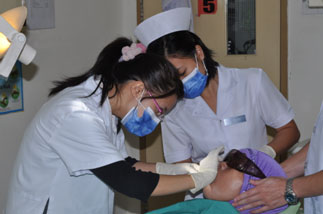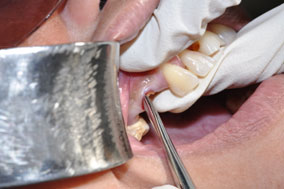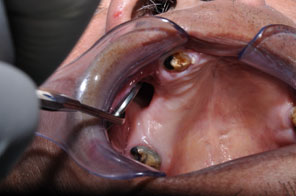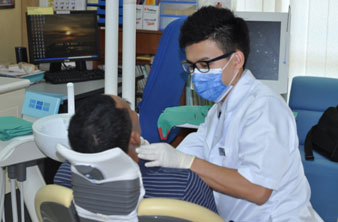Introduction
Tooth extraction is removal of the tooth. According to Howe (1961)1, “an ideal tooth extraction is defined as the painless removal of the whole tooth or tooth root with minimal trauma to surrounding tissues, so that the wound heals uneventfully”.
There are many reasons why a tooth needs to be extracted. They could be:
-
Severe tooth decay causing the tooth to be unrestorable;
-
Severe gum problems that cause loss of the supporting bone around the tooth consequently loosening the tooth;
-
Severe local infections;
-
Failure of root canal treatment (endodontic treatment) despite multiple attempts at retreatment or
-
Severely traumatized tooth
-
For the purpose of orthodontic treatment (a treatment to straighten the teeth), sometimes even a sound tooth may need to be extracted.

Different tooth, different potential complications.
From the preceding paragraph we can see that there are different indications for tooth removal. Every procedure has its own risks and complications. Sometimes even a simple tooth extraction can cause discomfort to the patient. There are many factors that can contribute to complications related to tooth extraction but people in general think that these complications are due to tooth-related factor only.
What are the factors influencing the complication of tooth extractions?
- Tooth related factors
- The anatomy of the tooth plays an important role determining the success of a tooth extraction. Teeth whose crowns are rotated, whose roots are curved, long and slender will be difficult to extract.
- Teeth which are heavily filled, root treated, brittle and very broken down are also difficult to extract.
- The hardness and thickness of the supporting bone: Normally, teeth that are located in hard and thick bone are difficult to extract.
- Patient’s factor
- Patient with underlying medical conditions such as Diabetes Mellitus (high glucose in the body), or are Immunocompromised (low body immunity). In such patients, healing process is poor and sockets are often infected. Sometimes the infection can spread throughout the body.
- Patients with a history of radiotherapy of the jaw and/or chemotherapy,e.g. for treating Nasopharyngeal Carcinoma (nose cancer). Irradiated jaws have poor blood supply. Therefore sockets tend to heal poorly. Non-healing of the socket in the irradiated jaw is called osteoradionecrosis.

- Oral hygiene of the patient – maintaining proper oral hygiene is very important during healing period. If food particles or debris is left trapped in the socket, the healing process will be interrupted.
- Smoking habit – smoking can also affect wound healing. This is because smoking reduce blood supply to the affected area, introduce toxins to the area and can injure the gums.
What are possible complications of tooth extraction?
- Pain: This is the most common complication after a tooth extraction. Most patients may experience mild pain. Severe pain may be related to an infection.
- Bleeding: Bleeding immediately after tooth extraction is normal. This will stop after some pressure is applied. The socket will be plugged with blood clot. However, those with a history of blood clotting problems, there will definitely be prolonged bleeding, e.g. Haemophilia, liver disease or on blood thinning agents. Hence, such a patient may experience significant blood loss after a tooth extraction.
- Infection: Poor oral hygiene and high glucose in the body can lead to an infection after an extraction. The most common condition (infection) after a tooth extraction is ‘dry socket’. As the socket dries out, it causes pain. It is a condition whereby, either there is no formation of blood clot in the tooth’s socket or the clot breaks down due to frequent mouth rinsing or smoking.
- Swelling: This may happen after a normal extraction as well as after a surgical procedure. Infection is one of the most common causes of swelling.
- Numbness: Normally occurs if there is injury to the nerves especially in the regions of the lower premolars and the wisdom teeth. It may be temporary or in some cases, severe injury to nerve can lead to permanent numbness.
- Incomplete extraction: This is usually a case if patient has a complicated tooth anatomy or the patient is experiencing an intolerable pain due to failure of anaesthesia during the extraction.
- Limited mouth opening: This is a common but temporary post-extraction problem amongst patients, usually due to pain when the effects of the anesthetic (numbness) have subsided. However, if the pain and limited mouth opening persist, this could be due to a hematoma forming (a swelling containing a collection of clotted blood).
- Injuries to adjacent teeth: The teeth adjacent to the extraction site might be fractured / chipped off or loosened during the extraction process. A filling might also be dislodged.
- Communication between mouth and nose (oro-antral communication or fistula): This is a rare complication. The site of this communication or fistula is at the molar region of the upper jaw (maxilla). A communication or fistula is deemed to have occurred if there is continuity between the oral cavity (mouth) and the maxillary sinus through the extraction socket. The maxillary sinus is the hollow in the bone of the maxilla. To assess whether a patient is having this complication, the patient is made to rinse or gargle with some water. If a communication or fistula exists, water will come out through the nose.

What is your plan of action when the complications mentioned above occur?
Please consult your local dentist. Some cases may need to be referred to an oral surgeon.

Reference:
- Howe, Geoffrey Leslie (1961). Extraction of teeth. Baltimore: Williams & Wilkins (Online version)
| Last Reviewed | : | 25 April 2014 |
| Writer | : | Dr. Khairulzaman b. Adnan |
| Accreditor | : | Dr. Shim Cheng Kiong |
| Reviewer | : | Dr. Kok Tuck Choon |







